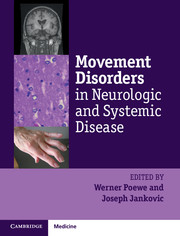Book contents
- Frontmatter
- Contents
- List of contributors
- List of videos
- List of abbreviations
- Preface
- Section I General principles
- Chapter 1 Phenomenology, classification, and diagnostic approach to patients with movement disorders
- Chapter 2 Pathogenesis of movement disorders: basic neuroanatomy and pathophysiology
- Chapter 3 Principles of management in movement disorders
- Section II Movement disorders in systemic disease
- Section III Iatrogenic and toxic movement disorders
- Section IV Movement disorders in general neurology
- Section V Systemic complications of movement disorders
- Index
- Plate Section
- References
Chapter 1 - Phenomenology, classification, and diagnostic approach to patients with movement disorders
from Section I - General principles
Published online by Cambridge University Press: 05 April 2014
- Frontmatter
- Contents
- List of contributors
- List of videos
- List of abbreviations
- Preface
- Section I General principles
- Chapter 1 Phenomenology, classification, and diagnostic approach to patients with movement disorders
- Chapter 2 Pathogenesis of movement disorders: basic neuroanatomy and pathophysiology
- Chapter 3 Principles of management in movement disorders
- Section II Movement disorders in systemic disease
- Section III Iatrogenic and toxic movement disorders
- Section IV Movement disorders in general neurology
- Section V Systemic complications of movement disorders
- Index
- Plate Section
- References
Summary
Introduction
In this introductory chapter, we will discuss the phenomenology of movement disorders and its importance in classification and diagnostic work-up in patients presenting with one or more types of movement disorders. We will place great emphasis on the most important step in this diagnostic process, which is the clinical approach based on recognition of the phenomenologic characteristics of the movement disorder. An accurate clinical description and adequate recognition of the type of movement disorder (or multiple types, as is often the case) in turn forms the basis for a tailored set of ancillary investigations to confirm the clinical suspicion. Thanks to rapid technological advancements (for example, in the fields of genetics and functional imaging), clinicians now have a battery of advanced ancillary investigations at their disposal. In this chapter, we will discuss the rational use of some of the most commonly required tests. However, we should point out that the clinical pattern recognition remains the vital starting point for any diagnostic approach, and that many ancillary investigations offer relatively little added value over and above the diagnostic accuracy of a clinical neurological examination (Constantinescu et al. 2009; Seppi and Schocke 2005; Morris and Jankovic 2012).
- Type
- Chapter
- Information
- Publisher: Cambridge University PressPrint publication year: 2014
References
- 1
- Cited by

